Bharatpur: Paradise Regained
by Bikram Grewal
8th - 10th February 2009
“Species generally become rare before they become extinct – to feel no surprise at the rarity of a species, and yet to marvel greatly when the species ceases to exist, is much the same as to feel no surprise at sickness, but, when the sick man dies, to wonder and to suspect that he died by some deed of violence” Charles Darwin in the Origin of Species
It is July of 2008 and every eye, in the ancient warrior land of Bharatpur, looks towards the cloud-laden skies, each lip murmurs the same silent prayer. Will Lord Indra, the rain god, finally forgive the errant politicians who wittingly sought the death of the beloved Keoladeo Ghana and shower her munificence on a land parched for over half a decade? The gods do not disappoint, the heavens open and a thirsty earth drinks and drinks till she can no more.
Pools that have lain empty for so long begin to fill, bringing with it the hopes of a million birds who had forsaken their right to give birth, to perpetuate their lineage. Their right to live. Openbills arrive in droves colonising the Kadams. Darters, Ibis, herons, egrets, and cormorants all follow. Squabbles breakout as each fights for a prime piece of property. Jacanas sprout long tails and lay eggs on floating leaves and the Sarus dances for the pure joy of it. Paradise has returned to the Garden of Eden. Soon visitors from faraway lands will come to seek food and shelter and myriad wings will cover the waters of Bharatpur.
I first went to Bharatpur when I was six years old and perhaps have visited it over a hundred times. Even at that early age I can clearly recall seeing over seventy Siberian Cranes, once the stars of Bharatpur. By 2002 they had dwindled to a meager three and then there were none. We took it as an ominous sign, a grim foreboding of things to come. The rains deserted Bharatpur in 2004 and politicians greedy for votes diverted water into the fields of their constituents. The Ajan Bund fed by the fecund waters of the Gambhir and Banganga Rivers lay empty. The then Chief Minister of Rajasthan declared People, not parks were her priority.
I wrote in my diary, after a visit to the park in April 2005 Summer takes on a whole new meaning. Keoladeo has weathered many droughts, but I have never seen it so burnt before. Water levels have turned critical. Dead fish are everywhere. The otters have left. Each day brings new hope that waters will be released from the Ajan Bund. No such luck. The 6000 feral cattle consume what the sputtering pumps churn up. It is the summer of discontent.
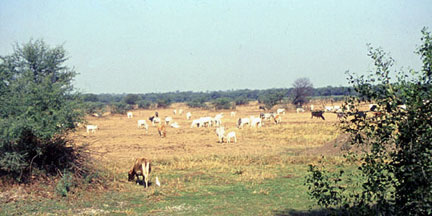
Matter went from bad to worse, consistent low monsoons, along with water politics turned this once verdant land into a virtual graveyard. Fishing cats disappeared and turtles lay thrashing in diminishing pools. From the nearly 400 species that the park boasted of, the numbers crashed to 48 last year, and the park that that saw over several hundred of thousands birds in a normal season, now barely held 4,000.
Needless to say the immediate economy, centered around the park collapsed: The hotels were empty and the rickshaw drivers starved.
The initial reaction to save the Ghana was as usual knee-jerk. Spluttering tube-wells that weakly regurgitated water were installed, which the feral cattle lapped up. A foolish plan to draw water through a pipeline from the Chambal River was scoffed by those who knew better. The water that would come all the way from Chambal would be inert and no real use to the park. More catastrophic was the problem of Prosopis juliflora, an exotic and invasive species that rapidly spreads, hampering the growth of other native species like Salvadora persica. Vegetation of the park started changing and with that some of the raptors and owls found their traditional hunting grounds run-over by this pernicious weed.
Bharatpur was dead. So bad was the situation that there were fears that the wetland would lose its World Heritage Status. If the park was to be regained, it was essential to rid the park of the prosopis. A monumental task, with no precedent. An innovative plan that benefited the local villagers was drawn up and the WWF pitched in financially. Through eco-development committees formed in villages surrounding the park, families were allotted plots of land from which they would clear the weed which they could use as fuel or sell. It was a great success and about eight km of the park was cleared, and nearly one lakh quintals of wood was extracted. Many paid off old debts and made pucca houses from the money earned by selling the wood.
Fortunately, in 2008, the rain gods obliged and some discreet politics, plus co-ordination with district administration saw water being released, in three phases, from Ajan. With new plans being drawn up for a permanent and uninterrupted supply water to be available, the park is well on its way to regaining its former glory.
So, it was under the burden of such history that Sumit Sen, Ramki and I decided to check for ourselves, whether the news of a refulgent Bharatpur were true or otherwise. Sumit was visiting after five years, it was Ramki’s maiden trip and I had made a few heart-breaking trips in between. We all gathered in Delhi, on the eve of the 7th of February, and after a convivial, if bibulous, evening prepared for an early morning start. Getting out of Delhi, by any of the exit roads, is a nightmare, but a 5 o’clock start can take the sting out of it and by six we were well on our way on the Agra highway and looking for an all-night dhaba that served allo-parathas. Satiated and having got our grease-fix, we entered the precincts of what were once the famous Kosi wetlands, now sadly diminished to handful of swampy pools on either side of the road. My two out-of-town photographer friends were itching to get their hands on their cameras and a yellow-eyed female Black-necked Stork presented a perfect target. A good start to the trip. Other birds of interest were a few Shovelers, Teals, Pintails and a single Woolly-necked Stork.
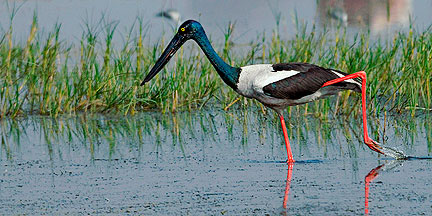
Black-necked Stork
We turned right, off the national highway at Mathura and kept a wary eye for some intrepid Brown Crakes that were reported by several delhibirders a few days back. Just as we crossed a bridge we came to a patch with a grassy nullah on the left, which hosted no less than three Brown Crakes. They were so engrossed in feeding that our close presence did not worry them and we photographed them for several minutes and they were still there when we reluctantly left.
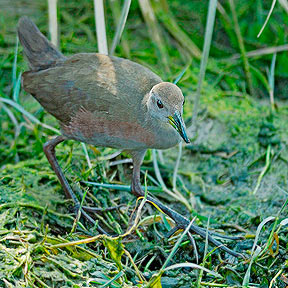
Brown Crake
A group of Egyptian Vultures sat around a carcass close to the road being harassed by village dogs who wanted a piece of this putrid pie. As we approached Bharatpur we passed through some prosperous looking farms, their tube-wells pumping life-giving water. I wondered if the farmers were even remotely aware of the hydrology of the swamps, or the recharge of aquifers, or that their future would be in jeopardy if the wetlands ceased to exist.
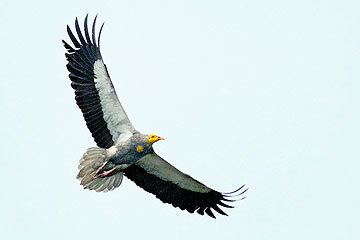
Egyptian Vulture
We had booked ourselves in Hotel Sunbird, next to the park gates and its affable owner Ranveer Sikarwas (+91-9414026026) was at hand to help us move our stuff. A quick lunch and we met up with our guide Baney Singh (+91-9414344149) and set off in two rickshaws. At first I was a bit disoriented by the altered landscape, since other plants had not yet replaced the recently uprooted prosopis and the still barren patches looked a bit like moonscape. I realised how successful the anti prosopis campaign had been.
One of the great attractions of Bharatpur has always been the Dusky Eagle Owl, and the park has a few pairs that breed within its confines and the great challenge is to manage a clear view of this massive bird, who prefers to hide in the leafy branches of huge and tall trees. For the photographer it is even tougher. Since Ramki was very keen to get a picture of this bird and I thought it best that that we overcome this obstacle as soon as possible, else he would drive us insane. Our guide confirmed that a pair were seen close to the road. However the park rules did not permit anyone to go off the road, close to the roost. In any case the surrounding area was underwater, preventing any foolhardy person to contemplate such action. This situation did not deter our intrepid photographer duo, who were determined to overcome all such obstacles. In this case it was to sit quietly hidden, till the bird was confident enough to come out into the open. Their plans were put to naught by the noisy arrival of a large group of very excited bird-watchers from Taiwan. Each carried the latest camera equipment, expensive binoculars and telescopes and wore high-fashion camouflage-clothing. They jumped from one vantage point to the other in an attempt to get a view of the hapless owl. Some fell into the water, others emerged from thorny bushes, their arms and legs bleeding from scratches, but all that mattered was a good look at the owl. We weathered this sudden oriental storm and thirty minutes later they had gone and calm returned as did the Dusky Eagle and we got the requisite photographs.
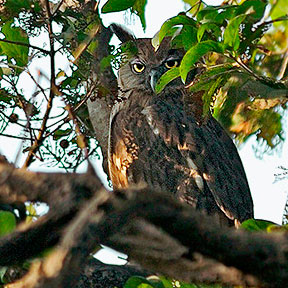
Dusky Eagle Owl
We moved on towards the Temple and I could see that the park had (almost) returned to its former glory. There was water on both sides and it teemed with ducks, geese, ibises, egrets and herons. A huge heronry has been created and the nests quivered with the clamouring chicks of Painted Storks. God was in heaven and all was well with the world. Sumit and I have been discussing, for the last few years, on how we thought that the population of the Comb Duck in India had been declining based on sight reports and how we ourselves had hardly seen them in recent times. Whatever misgivings we had were instantly dispelled by this current trip and it seemed that the entire Indian population had congregated here in the rejuvenated waters of the Keola Deo. Estimates varied from 4000 downwards, but they seemed to be everywhere and made for a truly heartening sight.
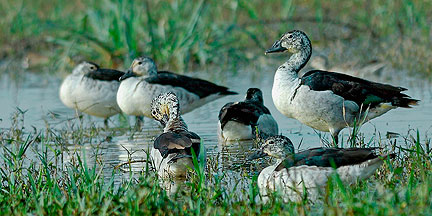
Comb Duck
One of the newer innovations that have taken place in the last few years is that the rickshaw path has now been extended beyond the temple. You can now take (or be taken!) past the old hunting records, and past the well (made famous by Simi Garewal in the film Siddartha!) towards Kadam Kunj till you come to a place that has now been christened Sankhala’s Hide (named after Rajasthan’s legendary forester Kailash Sankhala). It was here that we were headed, to get away from the crowds and to see the spectacle of several thousands ducks taking off when harried by a Eurasian Marsh Harrier. The waterbody, which we were circumventing, is known as Mansarovar and is one of my favourite areas in Bharatpur. In earlier times the Siberian Cranes obviously agreed with me and often fed and stayed in this spot. We moved on, turning right at a point that another vanished visitor– the Sociable Lapwing used to frequent.
Almost immediately we came upon a group of Glossy Ibis, the much-desired target of Sumit’s camera. To our left i.e. the Mansarovar was full of duck, running into thousands. When all was quiet, it was difficult to see them all as they lay hidden in the grass, but when a low-flying Marsh Harrier made a swoop, the hordes rose as one, and filled the air with the sound of myriad wings. This spectacle normally take place in the afternoons and we observed that the only birds that refused to be spooked, other than the geese, were the Comb ducks. We spent the rest of the evening there, moving only when the light faded.
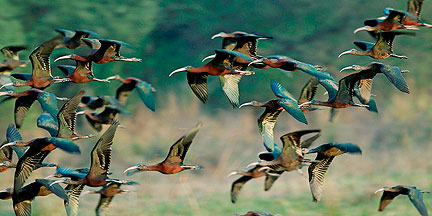
Glossy Ibis
Later in the day Supriyo and Bhaskar, birding friends from Kolkata who had arrived in the afternoon, joined us. We swapped experiences and agreed to rendezvous at the Nursery at first light. At the risk of sounding pompous, I must take some credit for popularizing the “Nursery” at Bharatpur. I discovered it quite by chance when, many decades back, I went wandering on my own and found this grove of tall trees, including some spectacular Peepuls. It held Grey Hornbills and Green Pigeons and I saw my first Tickell’s Thrush here. But most important it was a good place for day-roosting nightjars. These enigmatic birds were our quarry of the moment and the sharp-eyed Baney Singh soon found us a Large-tailed Nightjar a mere foot above the ground. It blended so perfectly with the habitat that when I finally saw it was less than three feet away. It’s smaller cousin the Grey Nightjar was found nearby but considerably higher on an acacia tree. While my four companions clicked away I wandered off, only to bump into my old friend Rattan Singh, rickshaw driver extraordinaire and now a famous bird-guide. He was leading a large group of birders, including the noisy Taiwanese and the cause of their excitement, it turned out, was the purported sighting of a White-tailed Robin, a bird of the High Himalayas and not seen for at least a thousand miles! Needless to say it was a rumour. I dragged my mates away but not before we glimpsed an Orange-headed Thrush in the undergrowth.
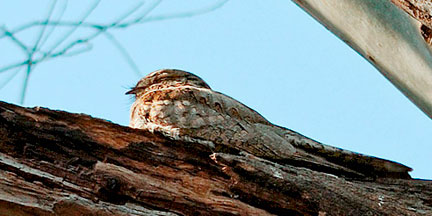
Grey Nightjar
The track from the nursery to the car park is dry and dusty but always good for Indian Peafowl and Grey Francolin, but much to our surprise a Barred Button Quail popped out from one of the bushes and hurried away before we could photograph it. We entered the park again and decided go back to Sankhala’s Hide, where Sumit wanted to capture Lesser Whistling Ducks squabble with each other and Ramki wanted to give the Black and the Yellow Bitterns we had seen the day before, another go. On the way we stopped as and when we saw raptors and by the end of the trip had notched up Oriental Honey-buzzard, Black-shouldered Kite, Crested Serpent Eagle, Shikra, White-eyed Buzzard, Greater and Indian Spotted Eagles, Steppe, Imperial Booted and Bonelli’s Eagles.
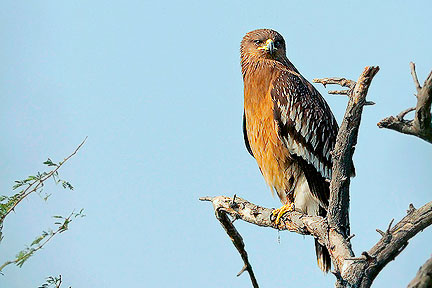
Greater Spotted Eagle
We had connived with Rattan Singh, that as soon as he jettisoned his group, we would leave the park and venture to some obscure part of Bharatpur town where he knew that the Greater Painted-snipe bred. But we were truly surprised when he took us to the middle of a brand-new housing-colony where some of the marshy areas were still to be drained. And sure enough there were the brighter hued and larger females, with their drabber males following them. I have always found this species to be terribly interesting particularly because of reversed sexual roles, the brighter and larger females fight for mates, lay eggs and move on leaving the males to bring up the kinder. In one season a female can find several different mates.
I explained this to Ramki who was fairly disturbed by this shocking show of feminism! This marshy bog also contained Spotted and Common Redshanks, Ruffs, Marsh Sandpipers and Temminck’s Stints.
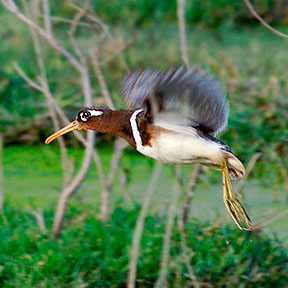
Greater Painted Snipe (female)
We returned to the park and saw a Dalmatian Pelican and a few distant Great Whites. It was good, however, to see that the Darters are doing well in the park. Sarus Cranes, though, not in the large numbers of yore, were very much in evidence as were their Common cousins.
Soon our short sojourn was over and it was time to return. We had seen most of the species that we had hoped to see and were truly delighted to see that the famous wetlands had returned to their former glory. All we need now is for Bharatpur to be in a position where it is not dependent for its survival on the whims of some corrupt and power-hungry politicians! The first step towards consolidating the Bharatpur Inheritance today must surely involve a return to the wisdom of the past, inherent in the 18th centaury wisdom of Raja Suraj Mal of Bharatpur who created the Ajan Bund and which was articulated two hundred years before him by Francis Bacon: “Nature, to be commanded, must be obeyed”.
|

